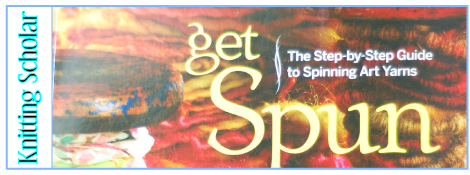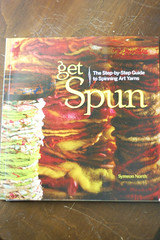First, the facts:
Title: Get Spun: The Step-by-Step Guide to Spinning Art Yarns
Author: Symeon North
Published by: Interweave Press, 2010
Pages: 118
Type: Spinning.
Chapters:
1. What Makes an Art Yarn?
2. Tools & Materials
3. Dye Fiber & Yarn
4. Blend Fiber & Color
5. Spinning Basics
6. Uncarded Fiber
7. Core Spinning
8. Add-ins
9. Unconventional Plying
10. Unspinnables
11. Artistic Inspiration: Combining Techniques
The In-Depth Look:
In the interests of full disclosure, I should tell you that I’m really not interested in spinning art yarns. Even a few years ago, when novelty yarn was all the rage, it didn’t appeal to me. I’m too traditional in my tastes and prefer yarn that looks and acts like, well, familiar yarn.
So, when I received this review copy, I wasn’t expecting to actually like the book. I figured it would be a good book, since Interweave’s usually are, but I didn’t expect it to be a book I would get much out of.
Yes, well, where do we keep the crow? Because this book is full of lots of interesting detail, even for a plain-vanilla kind of spinner like me.
The author starts out by asking, “What makes a yarn an art yarn and not simply a novelty yarn? Artistry and intention, of course. When you set out to create yarn that is an object of beauty, then you have an art yarn–even if that yarn is a gray cobweb-weight three-ply. Art, like beauty, is in the eye of the beholder.”
It’s that attitude which makes me appreciate this book. One, she’s not insisting that funky, novelty yarns are the only “art” yarns, but two, because she’s giving you the techniques you need to make your yarn–no matter what it is–on purpose.
She starts by talking about equipment, and number one is the spinning wheel because the author doesn’t use spindles, and number two is her drum carder, even before she gets to things like fiber (whether wool, cotton, or strips of cloth or feathers). If the only spinning you’ve done is on a spindle, you may not get quite as much out of this book as you might otherwise … although certainly can be done on spindles.
Next, she talks about dye and color, and this chapter explains some basic dyeing techniques, like kettle-dyeing in your slow-cooker, or handpainting. That’s followed by a really interesting chapter about using a drumcarder to make your own blends of fibers and color. Since I haven’t tried dyeing my own wool yet, the idea of blending my own with pre-colored fiber using a drum carder sounds fun. And easy (by which I mean less messy).
Then she gets into the actual spinning–thin singles, bulky singles, thick-and-thin singles–all with a nice discussion about twists and angles for the twist. Much of this is information you can find elsewhere, in more detail, but they are essential here because if the idea is to create your own yarn, from your own vision, you need to have control over the process–you can’t depend on finding the right shade of blue from somewhere else. Also, presumably by the time you’re trying to make creative, slubbed yarns, you’re past the beginner stage of spinning … if only because beginning spinners are constantly trying to eliminate slubs from their yarns.
It is the second half of this book that really addresses the “art yarn” genre. How to spin uncarded locks into multi-textural yarn, or spinning yarn with free-flowing locks to add interest and texture. Then there’s core-spinning–when you add fiber to a ready-made core, either by coiling it around it or adding to its twist. You can also add extras into your yarn–beads, sequins, feathers. Or maybe you want to get creative while plying your yarn, by spinning boucle yarn, or deliberately adding “worms” (those little plied-back-on-themselves coils that you get from highly energized singles). You can even turn fabric or plastic bags into yarn–the ultimate in recycling.
Ultimately, this book is FUN. Even if you prefer “regular” yarn like I do, part of the point of having art in the world at all is to broaden horizons and make us aware of possibilities we couldn’t see for ourselves. Sure, most of us may focus on trying to spin consistent, even yarns to knit into socks or sweaters, with no time for this kind of frivolous nonsense … except that it’s NOT nonsense, any more than somebody dyeing their wool bright pink or turquoise is “nonsense.” Even if you don’t think you want it in your wardrobe, sometimes you just need to step outside what you THINK are the boundaries of what is possible to see the broader horizons.
This mind-broadening, remarkably interesting book is available from Amazon.com.
Want to see bigger pictures? Click here.

This review copy was kindly donated by Interweave Press. Thank you!


